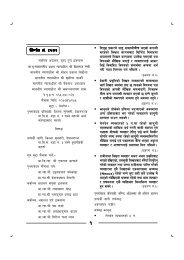The Nepali Judiciary - Supreme Court Of Nepal
The Nepali Judiciary - Supreme Court Of Nepal
The Nepali Judiciary - Supreme Court Of Nepal
You also want an ePaper? Increase the reach of your titles
YUMPU automatically turns print PDFs into web optimized ePapers that Google loves.
Executive Summary<br />
1.1 Preliminary<br />
With commitment towards providing continuity to the planned development process, the second<br />
edition of the Strategic Plan of the <strong><strong>Nepal</strong>i</strong> <strong>Judiciary</strong> has come before us within a short period.<br />
Recognizing that the experience and weakness of the past Plan would be a guideline for future<br />
plan, effort had been made towards preparing the basic Plan. In order to provide formality to the<br />
drafting process of the second Strategic Plan and pursuant to the recommendation made by the<br />
Plan Implementation Committee and decision dated 2066 Baisakh 28 made by the High-Level<br />
Directive Committee, a Planning Formulation Committee and Long-Term Task Force was<br />
constituted.<br />
1.2 Planning Process<br />
During the process of formulating the Plan, it was deemed that active participation of the<br />
stakeholders was necessary and keeping this as the focal point, written recommendation was<br />
sought from all the courts, tribunals and other judicial bodies. Discussions and interactions were<br />
held with the legal professionals, staff, organizations involved in the legal sector, representatives<br />
from the media and other relevant stakeholders. During the preliminary drafting of the Plan, the<br />
concerns and interest expressed by the participants were included.<br />
With the drafting of the preliminary Plan, consultation meetings were held at a regional level<br />
namely in Biratnagar, Pokhara, <strong>Nepal</strong>gunj and Kathmandu. Matters raised during the consultation<br />
meetings were discussed among the Task Force and Plan Formulation Committee wherein<br />
necessary reforms were made on the preliminary draft and the final draft was then submitted<br />
before the Chief Justice. <strong>The</strong>reafter, a meeting of the Full <strong>Court</strong> was held on 2066/3/31 wherein a<br />
decision to implement the Plan was taken by the Full <strong>Court</strong>. In order to make the execution of the<br />
Plan effective, it was decided to establish a Project Implementation Secretariat within the <strong>Supreme</strong><br />
<strong>Court</strong> and also to develop a mechanism for implementing the Plan in all the courts and to transfer<br />
skills so as to develop their capacity in formulating their work plans and in order to inform all the<br />
concerned stakeholders orientations and sensitization programs were decided to be organized.<br />
1.3 Basic Objective of the Plan<br />
<strong>The</strong> objective of the Plan was to establish a judiciary that was capable of executing the obligations<br />
vested by the Constitution thereby increasing public trust over the judiciary. <strong>The</strong> principal objective<br />
of the Plan was to guarantee the reforms by end of the Plan period. <strong>The</strong> Plan envisages the<br />
following objectives:<br />
• To review the first Strategic Plan of the <strong><strong>Nepal</strong>i</strong> <strong>Judiciary</strong> and to give continuity to the<br />
reformation process,<br />
• To analyze the prevalent resources and work of the judiciary and to identify people’s<br />
expectation from the judiciary, obligations and challenges in the changed context,<br />
• To determine strategic interventions so as to face the identified responsibilities and<br />
challenges and subsequently formulate implementation plan and make necessary financial<br />
resources deemed necessary.<br />
1.4 Structure of Plan<br />
<strong>The</strong> Plan has been presented in nine Chapters. <strong>The</strong> first chapter contains preliminary subject<br />
matters vis-à-vis background of the Plan, constitution of Plan Formulation Committee, planning<br />
process, basic objectives of the Plan, study methodology and implementation of Plan. <strong>The</strong> second<br />
chapter contains the vision, mission and values of the judiciary. Likewise, the third chapter makes<br />
a review of the first Strategic Plan, wherein core functions defined in the first Plan and<br />
achievements made in the area of strategic interventions and status of execution has been<br />
reviewed. Review has been carried out by making an analysis of the available data for the first<br />
four-years (Fiscal Year 2061-1065) and on this basis effort towards presenting the achievements<br />
gained and weakness faced by the Plan has been made. <strong>The</strong> fourth chapter identifies the<br />
strengths and weaknesses of the judiciary wherein opportunities and challenges of the judiciary<br />
i




![lg0f{o g+=&(&# g]=sf=k= @)^% ;af]{Rr cbfnt ljz]if Ohnf; ;DdfggLo k ...](https://img.yumpu.com/10045627/1/190x245/lg0fo-g-gsfk-afrr-cbfnt-ljzif-ohnf-ddfgglo-k-.jpg?quality=85)
![lg0f{o g+=&(@% g]=sf=k= @)^% ;jf]{Rr cbfnt, ljz]if Ohnf; dfggLo ...](https://img.yumpu.com/6479513/1/190x245/lg0fo-g-gsfk-jfrr-cbfnt-ljzif-ohnf-dfgglo-.jpg?quality=85)

![lgj]b s ljkIfL - Supreme Court Of Nepal](https://img.yumpu.com/5482729/1/190x245/lgjb-s-ljkifl-supreme-court-of-nepal.jpg?quality=85)